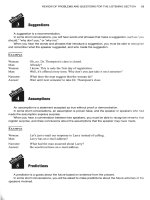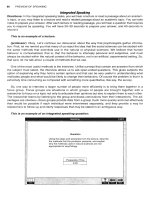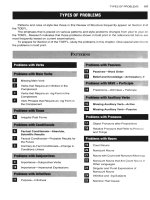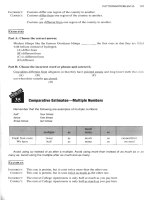Tài liệu How to prepare for the toefl part 9 pptx
Bạn đang xem bản rút gọn của tài liệu. Xem và tải ngay bản đầy đủ của tài liệu tại đây (480.5 KB, 10 trang )
COMPUTER TUTORIAL FOR THE LISTENING SECTION
75
In order to succeed on the Computer-Based TOEFL, you must understand the computer vocabulary
used for the test, and you must be familiar with the icons on the computer screens that you will see on
the test. First, review the vocabulary. Then study the computer screens in this Tutorial.
Testing Tools: Vocabulary, Icons, and Keys
General Vocabulary for the Compute~Based TOEFL
Mouse
A small control with one or two buttons on it.
Mouse
Pad
A rectangular pad where you move the
mouse.
Arrow
A
marker that shows you where you are moving on the
computer screen. Move the
mouse
on the
mouse pad
to
move the
Arrow
on the screen.
Click
To depress the button on the
mouse
is to
Click
the
mouse.
Click
the
mouse
to make changes on the
computer screen.
Icon
A small picture or a word or a phrase in a box.
Move the
arrow
to the
lcon
and
click
on the
lcon
to tell the computer what to do.
button
\
Pad
\
Mouse
Icons for the Computer-Based TOEFL
Dismiss
Directions
Oval
Next
Confirm
Answer
Help
Time
An example of an
icon. Click
on
Dismiss Directions
to tell the computer
to remove the directions from the screen.
The
icon
beside the answers for the multiple-choice test questions. Move the
arrow
to the Oval and
click
on one of the
Ovals
to choose an answer.
An example of an
icon.
To see the next question on the screen,
click
on
Next
first
and then
click
on
Confirm Answer.
An example of an
icon. Click
on
Confirm Answer
after you
click
on
Next
to see the
next question on the screen. Remember,
click
on
Next, Confirm Answer
in that
order.
An example of an
icon. Clickon
the question mark to see a list of the
icons
and directions for the section.
An
icon
of a clock in the bottom left corner of the screen.
Click
on the clock face to
hide or show the time you have left to finish the section of the test you are working
on. Five minutes before the end of each section of the test, the clock will appear
au-
tomatically. Remember, the time appears in numbers at the top of the screen, not on
the clock face. You cannot use the clock during the recording.
Specific Vocabulary for Section
1
Volume
One additional
icon
at the bottom of the screen in the Listening section.
Click
on
Volume
to go to a screen with an
up arrow
and a
down arrow. Click
on the
up arrow
to make the recording louder.
Click
on the
down arrow
to make the recording softer.
Remember, you can change the volume while the speaker is giving directions, but
not after the directions have concluded.
76
REVIEW
OF
LISTENING
COMPUTER SCREENS FOR THE COMPUTER-BASED TOEFL
1
View the number
of the question
on the screen
2
View the total number
of questions in the
section
i
another screen
See the first question
time remaining
minutes and seconds
Click again to remove
1
the time
Click to go to
1
another screen
2
Click on the directions
for the section or the
explanations of the icons
to mark a final answer
and go to the next
question
TIP:
When the icons are black, you can click on them. When they are gray, they are not functioning.
For example,
Confirm Answer
is gray until you
click
on
Next.
Then
Confirm Answer
is black. Re-
member the order to click on these two icons.
COMPUTER 'TUTORIAL FOR
THE
LISTENING SECTION
77
Computer Screens for Section
1
What does the woman mean?
0
She is surprised
by
the man's statement.
0
She does not believe the man.
0
She agrees with the man's statement.
0
She does not understand the man.
The oval will change from white to black
Click to go to another screen
with two arrows
Click louder
Click softer
1
Click on the oval beside
the
new answer
The oval will change from white to black
The oval beside your first answer will change
TIP:
Most of the questions on the Computer-Based
TOEFL
are multiple-choice. When you learn to
move the arrow to the oval and click on the oval, you will be able to answer most of the questions.
78
REVIEW
OF
LISTENING
You
must
enter
an
answer
before
you
can
leave
I
TO
CONTINUE
THE
TEST
previous question
Answer the question
TIP:
When you do not answer a question, or when you do not confirm your answer, this screen ap-
pears. You can spend a lot of time returning to questions that you have not answered. Don't skip ques-
tions in the Listening and Structure sections.
Simulations for Section
1
In order to prepare for the experience that you will have on the Computer-Based TOEFL, use the
CD-ROM that supplements this book. Locate the Listening section on the Model Tests. The computer
will simulate features of the Listening section on the Computer-Based TOEFL. These Model Tests are
computer-assisted.
As part of your study plan, be sure to review all of the questions in all of the Model Tests. Use the
Explanatory Answers on the CD-ROM or in Chapter
10.
Finally, take the Cumulative Model Test on the
CD-ROM. This test is computer-adaptive, which means that the computer will select questions for you
at your level of language proficiency.
If you do not have a computer, you can simulate some of the features of the Computer-Based
TOEFL. In Section
1
of Model Tests
1-8
in Chapter
8,
the questions are written out for you to read while
you listen to them. This is different from the Paper-Based TOEFL. Instead of the CD-ROM, you may be
using either an audio compact disk or a cassette. Pause the tape or compact disk occasionally to give
yourself more control of the time for each question. But be careful not to pause too often or you will not
be able to complete all of the questions within the total time allowed for the section.
ADVICE
FOR
SUCCESS
79
The Next Generation TOEFL will include comprehension passages with natural speech at a rate
that is normal for native speakers and a style that is appropriate for campus conversations and acade-
mic classroom interactions.
Chapter
12
of this book is a Glossary of Campus Vocabulary to help you understand the campus
context. The next edition of this book will include a new, revised Listening Chapter to provide you with
strategies to comprehend natural speech in academic situations.
Watch for
Barron's
How
to Prepare for the
TOEFL,
12th
Edition
to be published when the Next Gen-
eration TOEFL is introduced.
Be sure to adjust the volume before you begin.
Before you begin the Listening section, you will
have an opportunity to adjust the volume on your headset. Be sure to do it before you dismiss the di-
rections and begin the test. After the test has begun, you may not adjust the volume.
Do not let the visuals of people distract you from listening to the short conversations.
We all
respond in different ways to pictures. If you become too involved in looking at the
pictures, you may pay less attention to the recording. For the most part, the pictures of people are for
orientation to the short conversation. After you look briefly at the picture, give your full concentration to
the conversation. If you take the Model Tests on the CD-ROM that may supplement this book, first prac-
tice by watching the screen during the short conversation and then by closing your eyes or looking away
during the conversation. Find the best way for you to listen to this part of the test.
Focus on the visuals of objects, art, specimens, maps, charts, and drawings in the talks.
In
general, the pictures of people are for orientation to the talks, whereas the visuals of
objects, art, specimens, maps, charts, and drawings support the meaning of the talks. Do not focus on
the pictures of people. Do focus on the other visuals that appear during the talks. They could reappear
in a question. When you take the Model Tests, practice selective attention. Disregard the pictures of the
lecturer and the students, and be alert to the other visuals.
Be sure to read the question while you are hearing it.
The questions will be shown on the screen
while you are hearing them. If you find that it is to your advantage to close your eyes or look away dur-
ing the short conversations, be sure to give your full attention to the screen again while the question is
being asked. During the questions for longer conversations and talks, watch the screen carefully.
By
using the Model Tests, you will be able to develop a rhythm for interacting with the screen that is to your
advantage.
This advice from Dr. Charles Swindell is framed on the wall of my office near my computer so that I
can see it every day.
I
am happy to share it with you:
''The longer I live, the more
I
realize the impact of attitude on life. Attitude to me is more important
than facts. It is more important than the past, than education, than money, than circumstances, than
80
REVIEW
OF
LISTENING
failures, than successes, than what other people think or say or do.
It
is more important than appear-
ance,
giftedness.
or
skit\-
The remarkable
thing
is.
we
have
a
choice every
day
regarding
the
attitude
we
will embrace for that day. We cannot change our past
.
.
.
we cannot change the fact that people may
act in a certain way. We cannot change the inevitable. The only thing we can do is play on the one string
we have, and that is our attitude.
I
am convinced that life is
10
percent what happens to me and
90
per-
cent how I react to it.
And
so it is with you. We are in charge of our attitudes."
Henry Ford said it another way:
"If you think you can or you think you can't, you are probably right."
PREVIEW
OF
SPEAKING
DIRECTIONS AND EXAMPLES FOR SPEAKING QLlESTlONS
83
QUICK COMPARISON-SPEAKING
PAPER-BASED TOEFL,
COMPUTER-BASED TOEFL, AND NEXT GENERATION TOEFL
Paper-Based TOEFL Computer-Based TOEFL Next Generation TOEFL
There is NO speaking There is NO speaking section. Three types of questions are
section. presented in six sets. The first
two sets have a general
question; other sets have
questions about campus
and
academic topics.
After you see and hear the
general questions, you will have
15
seconds to prepare your
answers and
45
seconds to
record them.
After you hear the campus and
academic questions, you will
have
20-30
seconds to prepare
each answer and
60
seconds to
record it.
The Speaking Section of the TOEFL tests your ability to speak in English about a variety of general
and academic topics. The Speaking Section is not included in either the Paper-Based TOEFL
or
the
Computer-Based TOEFL. It is included in the Next Generation TOEFL.
Paper-Based TOEFL (PBT)
There is no Speaking Section on the current format of the Paper-Based TOEFL; however, there
are
plans for a telephone administration of speaking for future tests.
Computer-Based TOEFL (CBT)
There is no Speaking Section on the current format of the Computer-Based TOEFL.
Next Generation TOEFL
There are usually six questions in two parts on the Speaking Section of the Next Generation
TOEFL.
The questions are presented only one time. You may take notes. The topics are both general
and academic. There are two types of tasks included in the Speaking Section: two independent speak-
ing tasks and four integrated speaking tasks.
84
PREVIEW
OF
SPEAKING
Independent Speaking
Directions:
In the independent speaking tasks, yoti will hear questions about familiar topics. You can use
your personal experience and general knowledge to answer. After each question, you have
15
seconds to
prepare your answer, and
45
seconds to record it.
This
is
an example of an independent speaking question:
Question
Some students join clubs and participate in campus
activities. Other students spend all of their time
study~ng. Which l~festyle do
you
think is better
and why?
1
DIRECTIONS AND EXAMPLES FOR SPEAKING QUESTIONS
85
This is an example
of
an answer that receives an excellent rating:
"When I go to college,
I
plan to join at least one
club and participate in some of the activities.
Being part of a club is a good way to make
friends because
. . .
you have something in
common, and.
. .
and if I can make friends with
Americans, I'll probably improve my English.
And activities are also a good way to relax.
Studying all the time is uh stressful, and breaks
are good for your health. Um
.
.
. another rea-
son to participate in activities is to demonstrate
that you lead a balanced life. Some of the
scholarship committees are looking for addi-
tional qualities, like leadership or community
service as well as high grades, and when you
have extra.
. . extra-curricular activities on your
application, it can help you get a scholarship or
admission to graduate school. So I think stu-
dents who study all the time
.
.
.
they miss out
on
a
lot of opportunities for friendship and
maybe even for a scholarship."
Checklist
for
Independent Speaking
Ef
The talk answers the topic question.
d
The point of view or position is clear.
Id
The talk is direct and well-organized.
Id
The sentences are logically connected to each other.
Ef
Details and examples support the main idea.
d
The speaker expresses complete thoughts.
Id
The meaning is easy for the listener to comprehend.
Id
A
wide range of vocabulary is used.
Ef
There are only minor errors in grammar and idioms.
Id
The talk is within a range of
125-1
50
words.









